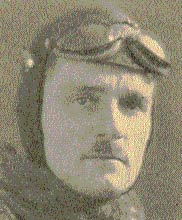Carl Spatz, ca. 1932
(Source: NASM)
 |
Carl Spatz landed at Tucson and signed the Register six
times between 1927 and 1931. He was a prolific figure in
military aviation during WWI, through the Golden Age and
into WWII and beyond. There are literally tens of thousands
of Web references about him.
His experiences included aerial
combat during WWI, record flights, base command and generalship
during WWII, and he was the first chief of staff of the Air
Force, appointed in 1947 by President Truman when the Air
Force became a separate branch of the military services.
He was an Early Bird of aviation, having soloed before December
17, 1916. On August 12, 1951, the Reading
Municipal Airport in Reading, PA was dedicated as the General
Carl A. Spaatz Field. Why the difference in spelling of his surname? Spatz changed the spelling of his
name to Spaatz in 1938 to emphasize the correct pronunciation
of the long "ah", as in 'spots' instead of 'spats'.
His nickname "Tooey" came from his supposed resemblance
to a West Point predecessor named Toohey. See the Cosgrove Collection on this site for
images of Spatz when he was "Spatz".
Carl Spatz was born June 28, 1891 at Boyertown, PA. He graduated
West Point in 1914 and was assigned to Schofield Barracks,
Honolulu. He transferred to the Signal Corps in 1915 and
learned to fly in San Diego, CA, receiving his wings in June
1916. He was assigned to the 1st Aero Squadron and served
with Pershing in Mexico.
He served in France during WWI, receiving the Distinguished
Service Cross and promotion to major. One experience he had there was documented in Popular Aviation magazine, August, 1931. It seems he was not satisfied with his role as trainer of pilots in France. He arranged to acquire an armed fighter and flew east over the German lines to do some damage. The article is at the link (PDF 458Kb).
Spatz returned to the
United States in October 1919 to take command of Kelly Field
until 1921, commander of the 1st Pursuit Group, Ellington
Field, TX and Selfridge Field, MI until 1924, then with the
office of Chief of Air Corps in charge of the Training and
Operations Section until 1929. We find him at Tucson on July 8, 1927
on his way to Langley
Field flying a Douglas C-1C Transport,
probably in formation with Ralph
Royce.
At about the end of his stay
with this Section, he and a group of fellow signers of the
Register embarked, In a Fokker transport aircraft, on an endurance flight at San Diego on
January 1, 1929. Below, courtesy of friend of dmairfield.org, John Underwood, is a photograph of Spatz just after their record flight. Note the "?" painted on his jacket.
Carl Spatz, January 10, 1929, Location Unknown (Source: Underwood)
 |
A summary of the flight of the Fokker C-2, 28-120, "Question
Mark" is found at the Cosgrove Collection (PDF
367KB; image, below, from this document). Spatz and his men
landed at Tucson with this airplane on
January 21, 1929 on their way eastbound, from San Diego to
Washington, DC, after their endurance record. Other members
of the crew listed in the Register were Ira
C. Eaker,
Roy Hooe, Elwood Quesada and Harry Halverson. See this link for
another image of the "Question Mark" from the Klein
Archive. And see this link,
also from the Klein Archive, for another image of Spatz during
WWII.
The Fokker Trimotor "Question Mark"
(Source: NASM)
 |
As an interesting
aside that you probably won't find in your Google searches
for Spatz, I present this
logistical scheme for the "Question
Mark" flight that I found in the Spatz records at the Smithsonian
(cited in the left sidebar). This PDF download (357KB; 9
pages) highlights specifically, 1) the responsibilities of
the many personnel outside the aircrew, 2) flight schedules
for the "Question Mark" and its support aircraft, and 3)
procedures for air-to-air and air-to-ground signaling (the
"Question Mark" carried no radios). If you enjoy esoteric
military detail, you'll enjoy this.
After the flight of the "Question Mark", Spatz was
ordered to Rockwell Field, San Diego, CA in May 1929 to command
the 7th Bombardment Group through 1931. Along the way he
acquired Transport Pilot license number 1555. See this link,
and many others, for biographical details. Carl Spaatz died
July 14, 1974 of congestive heart failure.
---o0o---
Dossier 2.2.165
THIS PAGE UPLOADED: 01/17/07 REVISED: 10/29/07, 03/05/09, 03/15/10, 07/31/14
|




